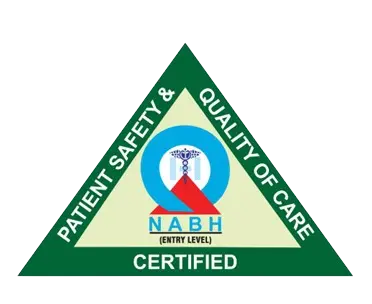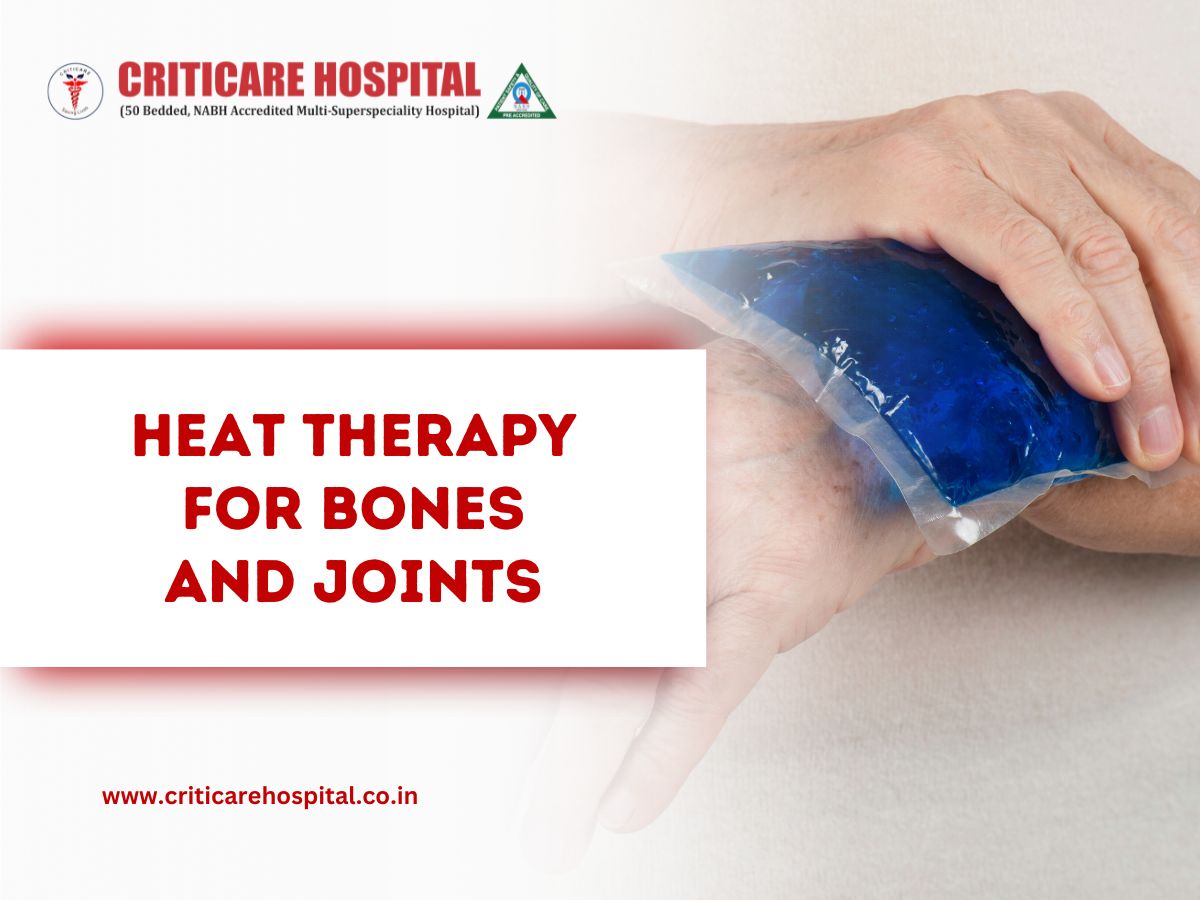Ever wrapped your fingers around the warmth of a cup of tea and felt that soothing relief? That comforting sensation is heat, and when joint or bone pain comes, the warmth does more than just offer comfort. In Criticare Hospital, we trust that modern concepts of medicine must equally deal with some time-tested therapeutic practices in the evolution of a pain-free life. One of those time-honoured healing arts would be heat therapy.
Be it arthritis, injuries, or wear and tear affecting you every day, this blog is reformative in giving you a complete revelation on everything about heat therapy, what it is, when to use it, and how to apply it correctly.
What Is Heat Therapy for bones and joints?
Heat therapy, or thermotherapy, offers heating through one or more means to balance muscular, joint, and bone pains and stiffness. It is one of the oldest and simplest forms of the treatment of pain, and its acceptance remains till today for use in the hospital and at home.
Heat applied to a painful or rigid area releases the tension in the muscles, provides internal blood flow, and makes connective tissue more flexible around that region. The pain reduction can speed up healing.
Why Is Heat Therapy Used for Bone and Joint Pain?
The causes of bone or joint pain include arthritis, osteoporosis, injuries, and overuse. Heat therapy, thus, works in many different ways in relieving pain and promoting recovery
Enhances Blood Circulation
Heat causes blood vessels to dilate, increasing blood flow in that particular area. The greater the blood flow, the more oxygen and nutrients are delivered by the blood to injured tissues, and they are healed more rapidly.
Relieves Muscle and Joint Stiffness
Joint ailments with osteoarthritis, and many others, result in stiffness, more so in the morning or post-inactivity. Heat therapy would loosen the area and allow freer movement and less pain.
Decreases Pain Perception
With heat, pain signals are reduced in their transmission to the brain and thus create a kind of natural analgesic effect.
Range of Motion
Because heat relieves the muscles and soft tissues around the joints, it assists in bringing back normal movement in joints that feel stiff or “locked up.”
Types of Heat Therapy
There are multiple types of heat therapies, each with its own way and horizon of application. Your choices will depend on how the pain is felt and where the pain is felt.
Dry Heat (Conducted Heat)
Heating pads, heat wraps, lamps that emit infrared rays, and a steam bath.
Best For: It is for surface-level pain or chronic joint stiffness, such as that below the back or knees.
Pros: Easy to apply, constant in temperature, and readily available.
Cons: It can dry out the skin; it should be applied cautiously on skin sensitive in nature.
Moist Heat Therapy (Convection Heat)
These treatments may include warm water baths for one, steamed towels for another, and moist heat packs.
Best For: Deep muscle pains and joint pains (for example, shoulder or hip).
Pros: Deep penetration of tissues and soothing potential when compared to dry heat.
Cons: Messy or inconvenient for some.
Paraffin-Wax Treatment
A warm wax treatment for hands and feet.
Best For: Arthritic pain or stiffness in small joints: fingers or toes.
Pros: Soothing deep heat and conditioning of the skin.
Cons: Not usable if there are open wounds or skin infections.
How to Safely Use Heat Therapy
Most heating procedures are safe if applied properly, but a few important points apply.
Check the Temperature
The temperature should not be too hot. It should feel warm and comfortable between 37°C and 45°C (98°F to 113°F). If too hot, one may get thermal burns or aggravated inflammation.
Time of Application Should Be Limited
It should not go beyond 15 to 20 minutes for smaller body parts, such as the wrist or ankle, or 25 to 30 minutes for larger body parts, such as the back or the hips. Suitable for anything beyond that will invite skin irritation and damage.
Make Use of a Barrier
Do not put heat directly on the skin. If you are dealing with a hot water bottle or an electric heat pad, always provide some distance by wrapping a towel or cloth to safeguard against burning.
Keep Well Hydrated
Whole-body processes like sauna or hot bath require water for hydration.
When Not to Use Heat Therapy
In several situations, heat therapy may be beneficial; however, it should never be used in others:
- Recent injuries or swelling: If the injury is recent-six hours, 48, or rather less-so much of that matters to develop swelling on the limb, cold therapy is prescribed to reduce inflammation.
- Open wounds or skin infections: Heat can support the growth of an infection; therefore, vitamins are discouraged for hastening wound healing.
- Poor circulation or nerve damage: If you have a case of diabetes or neuropathy, you may not be able to judge the heat properly, and you would risk some burns.
- Deep vein thrombosis (DVT): Heat may dislodge a clot with dire consequences.
In any case, always check with your doctor first before using heat, especially if you have an existing medical condition.
Medical conditions most suitable for heat therapy
Our specialist at CritiCare Hospital often asks for heat therapy as part of a bigger treatment plan for:
- Osteoarthritis
- Rheumatoid arthritis
- Fibromyalgia
- Chronic low back pain
- Muscle stiffness and spasms
- Tendinitis (in its non-acute phase)
- Menstrual cramps
Heat Therapy Tips at Home:
Few simple and inexpensive ways to incorporate heat therapy into everyday life:
- Warm Bath: Erupt for a warm soak (with Epsom salts) for about 15-20 minutes to relax snug joints and muscles.
- Soak a sock with rice for heat: Fill a clean sock with dry rice. Microwave for one to two minutes and apply to an aching joint.
- Reusable heat packs: Sold even at pharmacies and are easy to carry around.
- Electric heating pads: With a range of temperature settings that can be adjusted as required, they are perfect for home use.
Heat Therapy Complementing Other Treatments
Heat therapy works best as a continuum of care intertwined with:
- Physiotherapy: Stretching and strengthening exercises work best with heat.
- Medication: Painkillers and anti-inflammatory drugs make the heat therapy more effective.
- Lifestyle Changes: Good food, moderate exercise, and maintaining a balanced weight mean less stress on joints.
Our team at CritiCare Hospital offers you the option of a personalized recovery program integrating heat therapy with other scientifically validated treatments.
When to See a Doctor
Orthopaedic doctors suggest visiting a specialist if you’ve been using heat therapy for more than a week with no improvement or if your condition is worsening. Unyielding joint or bone pain could be an indication of a more serious affliction requiring proper medical diagnosis.
At CritiCare Hospital, a consultation and treatment by the best orthopedicians in Lucknow and physiotherapists are provided to ensure the patient is relieved in the long term and can regain movements.
Final Thoughts:
Heat therapy remains a safe, easy-to-use, and effective method for alleviating many issues with bone and joint pains. Be it chronic arthritis or an incessant injury, the appropriate application of warmth might just be your first step to permanent iterations of relief.
Remember: not all pain is created equal, and not all heat therapy is the same. When done properly, heat therapy is one of the natural ways you can help with pain relief and the body’s healing process. In case heat therapy is a question you’re asking yourself, then the CritiCare Hospital is ready for you. The experts will do their very best to help you.”




